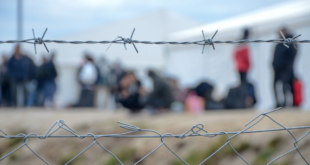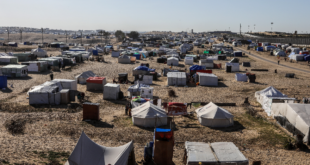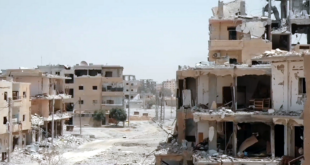Nuclear official claims enrichment ongoing; Tehran claims person behind attack identified; FM Zarif says damage to centrifuges will lead to installation of more advanced versions
Iran’s foreign minister on Monday blamed Israel for a power failure that reportedly caused massive damage to the Natanz nuclear facility, vowing to “take revenge on the Zionists” and to replace damaged centrifuges at the site with even better ones.
Meanwhile, according to Reuters, Tehran claimed it had identified the individual behind the attack and would arrest him. The report was based on the comments of an unnamed intelligence official who spoke to the Nournews website.
And Ali Akbar Salehi, the head of Iran’s nuclear program, said officials had launched an effort to provide emergency power to the nuclear facility. He said the sabotage had not stopped enrichment there, without elaborating.
The apparent sabotage at the site was reported by the New York Times to have been caused by a massive blast at the centrifuges’ power supply. Israeli and US media quoted unnamed intelligence sources as saying it was believed to have caused significant damage to the centrifuges and set back Iran’s uranium enrichment ability by at least nine months.
Mohammad Javad Zarif’s latest statements blaming Israel were made during meetings with the Iranian parliament’s National Security Committee Monday, according to Iranian media.
“The Zionists want to take revenge on the Iranian people for their success in lifting the oppressive sanctions,” Zarif was reported to say, “but we will not allow it and take revenge on the Zionists themselves.”
Zarif said Israel had sought to block the removal of international sanctions against Iran, but that “the Zionists will get their answer in further nuclear progress.”
He said older first-generation centrifuges that were damaged in the alleged cyberattack could now be replaced with newer, better machines, some of which Iran has already been using in breach of the 2015 nuclear deal.
“If they think our hand in the negotiations has weakened, this will happen to strengthen our position… The negotiating parties should know if they faced an enrichment facility with 1st generation centrifuges, now Natanz can be full of advanced centrifuges.”
The top Iranian diplomat also told lawmakers that better protection was needed at sensitive sites to prevent further such incidents, the reports said.
A spokesman for the foreign ministry made similar comments, saying Israel was “of course” behind the attack.
“Of course the Zionist regime, with this action, tried to take revenge on the people of Iran for their patience and wise attitude regarding the lifting of sanctions,” spokesman Saeed Khatibzadeh said at a press conference.
According to Khatibzadeh, the attack affected a number of first-generation IR-1 centrifuges “which will all be replaced with advanced” ones.
He vowed that Iran’s response to the attack would be “revenge on the Zionist regime” when and where Tehran chooses. “If the purpose was to interrupt the path of lifting the oppressive sanctions against Iran, they will certainly not reach their goal”.
Iran has called the incident an act of “nuclear terrorism.”
Senior Israeli officials Israel hinted at, but did not confirm, involvement in the apparent cyberattack, although the New York Times cited American and Israeli intelligence officials confirming that there had been an Israeli role.
An unnamed intelligence official told Israel’s Kan news that the damage at the site was “extensive” and that several “different types of centrifuges” installed at the top-secret underground center were harmed, setting back Iran’s ability to enrich uranium. Iran had publicly inaugurated cascades of advanced IR-5 and IR-6 centrifuges at the facility on Saturday.
The source said Iran’s abilities had been seriously set back and that the timing of the apparent strike was not coincidental.
Israel’s Channel 13, also citing unnamed intelligence officials, offered a similar assessment, saying that the cyberattack caused “severe damage at the heart of Iran’s enrichment program.”
Meanwhile, the New York Times, citing two intelligence officials briefed on the damage, said that “it had been caused by a large explosion that completely destroyed the independent — and heavily protected — internal power system that supplies the underground centrifuges that enrich uranium.”
In the early hours of Sunday morning, the underground Natanz facility suffered an electrical disruption in what was widely speculated to be an Israeli cyberattack. Iran said the attack did not cause any casualties and did not cause radioactive pollution. Israel has officially refrained from commenting on the matter, and Iran has not specifically accused the Jewish state of being responsible for the incident.
On Sunday evening, unnamed intelligence sources were cited by a number of Hebrew news outlets as saying that the Mossad was involved in the attack.
Israel made no official comment on the incident, but officials, from Prime Minister Benjamin Netanyahu on down, hinted at Israeli responsibility.
The Israeli comments, along with Hebrew media reports attributing the cyberattack to the Mossad, marked a significant change. Israel is normally completely silent on the secret exploits of its security services, and Israel’s military censor routinely prevents publication of such details, forcing local media to cite foreign media reports. But that did not happen this time.
Prime Minister Benjamin Netanyahu appeared to refer to the recent events in Iran at a ceremony honoring the country’s security forces on Sunday night, saying that the fight against the Islamic Republic was a massive undertaking.
Sunday’s incident came as US Defense Secretary Lloyd Austin landed in Israel for talks with Netanyahu and Gantz. The US, Israel’s main security partner, is seeking to reenter the 2015 atomic accord aimed at limiting Tehran’s program so that it cannot pursue a nuclear weapon — a move staunchly opposed by Israel, particularly Netanyahu.
In addition to an ongoing, largely covert fight on the nuclear front, Tehran and Jerusalem are engaged in a maritime shadow war, with both sides blaming the other for explosions on vessels.
In recent months, at least two Israeli-owned cargo ships have been damaged in alleged Iranian attacks, one in the Gulf of Oman and the other as it was sailing to India.
IDF Chief of Staff Aviv Kohavi appeared to reference the recent tensions between Israel and Iran in a speech on Sunday.
The Israeli military’s “operations in the Middle East are not hidden from the eyes of the enemy,” Kohavi said. “They are watching us, seeing [our] abilities and weighing their steps with caution.”
The timing of the apparent cyberattack came the day after Iran celebrated its National Nuclear Technology Day; the day after Iranian scientists began operating more powerful centrifuges; and amid ongoing talks in Vienna aimed at revitalizing the flagging 2015 nuclear accord between Iran and world powers, which Israel fiercely opposes.
The disruption at Natanz appears to have been designed to counter Iran’s efforts to raise pressure on the United States by amassing greater quantities of uranium and enriching it to higher levels as the two sides negotiate a return to the 2015 nuclear deal.
The spokesman for Iran’s atomic program, Ali Akbar Salehi, confirmed that the electrical disruption at Natanz was a deliberate act of sabotage, calling it “nuclear terrorism.”
In comments carried by Iranian state news, Salehi refrained from identifying a perpetrator, but said the attack was carried out by those who oppose Iran’s ongoing negotiations with the West to remove the sanctions against Tehran through the nuclear deal.
The Natanz nuclear facility, which maintains aboveground workshops and subterranean uranium enrichment halls, is considered a major facet of Iran’s atomic program. The alleged Israeli attack against it came hours after scientists at the site turned on a chain of 164 advanced IR-6 centrifuges that threatened to shorten the amount of time it would take for Iran to amass the highly enriched uranium needed for a nuclear bomb.
On Saturday, officials also began testing the IR-9 centrifuge, which they say will enrich uranium 50 times faster than Iran’s first-generation centrifuges, the IR-1. The nuclear deal limited Iran to using only IR-1s for enrichment.
Natanz was largely built underground to withstand enemy airstrikes. It became a flashpoint for Western fears about Iran’s nuclear program in 2002, when satellite photos showed Iran building its underground centrifuges facility at the site, some 200 kilometers (125 miles) south of the capital, Tehran.
Last summer, an explosion rocked the Natanz facility, in what was also said to have been an Israeli attack aimed at disrupting uranium enrichment and research at the site.
In 2010, the United States and Israel allegedly halted Iran’s nuclear program with the Stuxnet virus, which caused Iranian centrifuges to tear themselves apart, reportedly destroying a fifth of the country’s machines.
Iran has also blamed Israel for the killing last year of scientist Mohsen Fakhrizadeh, who began the country’s military nuclear program decades earlier.
 Eurasia Press & News
Eurasia Press & News




